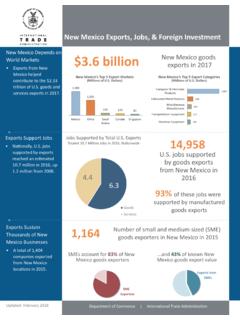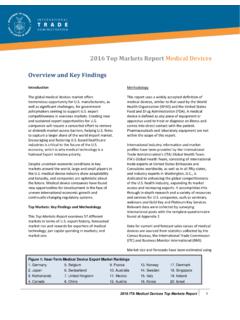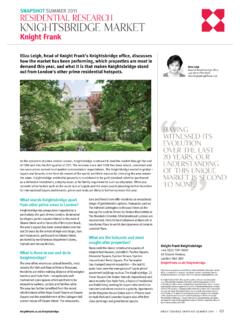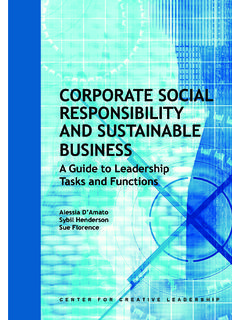Transcription of Cosmetics & Toiletries Market Overviews 2015
1 Cosmetics & Toiletries Market Overviews 2015 Compiled by Commercial Service Hong Kong For additional informatio n or Market re search pleas e visi t the Market Research Library at to find Country Commercial Guides (CCG) and industry Cosmetics , Toiletries and Skincare Market Overviews 2015 Table of Contents Prospective Markets Comparison by Import Market Size & Market Entry 3 Market overview and Shares of Cosmetics & Toiletries Exports 4 Individu al Co untry Reports Australia 6 China 8 Hong Kong 19 India 30 Indonesia 38 Japan 44 Malaysia 51 New Zealand 61 Philippines 63 Russia 67 Singapore 72 South Korea 74 Taiwan 82 Thailand
2 88 Turkey 90 United Arab Emirates 95 Vietnam 100 Contact List for Cosmetics / Toiletries Industry Specialist 104 3 Cosmetics , Toiletries and Skincare Market Overviews 2015 Comparison by Import Market Size and Market Entry ** 2009 *2008 C&T: Cosmetics & Toiletries Country Population (million) Current GDP per Capita (US$) C&T Market Size (by import values) (US$ million) Import Duty Rate on C&T (%)
3 Regulations L=Labeling R=Registration CFS= Cert of free sale GMP= Cert of Good Mfg Practices V/S=VAT /Sales Tax, O=Other Japan 37,800 13,874 L, O Russia 24,800 13,500 L, R, CFS, V, O China 1, 12,900 11,881 L, R, V South Korea 35,400 6,300 0-8 R, CGM, CFS, O India 1, 5,800 3,330 L Australia 46,600 2,800 0 L, R, V/S Turkey 19,600 2,250** 20 R, V/S Thailand 14,400 2,025 30 R, CFS/ CGM Hong Kong 55,200 2,000 0 None Indonesia 10,200 1,500 0-10 L, R, V, S, CFS Taiwan 43,600 1,230 R, CFS, V Malaysia 24,500 604* 0-25 L, R, CFS, CGM Philippines 7,000 438 1-10 L, R, V Singapore 81,300 400 0 L, R,V/S New Zealand 35,000 375 0-5 L United Arab Emirates 65,000 Not available 5 L, R, O Vietnam 5,600 Not available 20-30 R, CFS, V, O 4 Cosmetics , Toiletries and Skincare Market Overviews 2015 Market overview This report covers 17 markets: Australia, China, Hong Kong, India, Indonesia, Japan, Malaysia, New Zealand, Philippines, Russia, Singapore, South Korea, Taiwan, Thailand, Turkey, United Arab Emirates, and Vietnam, with a combined population of about 250 million.
4 These 17 markets have a combined Cosmetics and Toiletries Market worth of US$60 billion. In several of the largest markets like Russia, India and China, Cosmetics and Toiletries constitute less than 3% of the total Market size. Therefore, there are tremendous export opportunities for companies. Japan is the regions largest Cosmetics and Toiletries Market followed by Russia, China, and South Korea. Market penetration of international brands in India and Indonesia is still very low. Hong Kong whose Market size is about 17% of China s, imports about the same amount of Cosmetics and Toiletries from the And Hong Kong has one of the most open Market for selling Cosmetics and Toiletries , as it has no registration or labeling requirements, no import duties or value-added taxes.
5 Not all of the markets are free markets like Hong Kong. China, South Korea, Russia, Thailand and many others have stringent registration requirements but are not inaccessible; it only requires the appointment of an experienced local importer/distributor that is familiar with the regulations. Market entry strategies vary from Market to Market , but most countries require the appointment of a local distributor/agent to handle the registrations and execute the best marketing and selling strategy to suit local conditions. In Thailand and Taiwan, direct selling is prevalent and effective and in Japan it is growing in popularity.
6 In China, E-commerce of Cosmetics and skin care products is prevalent. Cosmetics and toiletry suppliers are known for being innovative and for producing quality and technologically-advanced products at competitive prices in most of the Asia Pacific markets. In this region, Cosmetics and toiletry products faces stiff competition from Japanese and French products. The innovative packaging and the Asian consumers perception that Japanese products are more suitable for Asian skins have sometimes given Japanese products the edge over American and European products. It is therefore crucial that exporters modify product names and packaging to suit local demand.
7 While a product made for whitening skin is politically incorrect to use in the , skincare products for lightening pigmentation spots on the face are best simply named whitening products rather than lightening products or brightening products. A smaller product size is required in Hong Kong to suit the younger consumers tastes, and for ease of carrying in bags but in China, the Philippines, India or Vietnam, a smaller size is required for affordability as the unit costs is lower than for a standard American-size item. Each Market also has its own sectors that had better selling prospects than others. While most markets cite anti-aging, hair products, make-up, whitening skincare products and sun-screen and sun-care products as the sectors with the best sales prospects, in the Philippines, whitening deodorant and underarm products are among the products with the best sales prospects.
8 Mass- Market products sell better in India and Vietnam than premium products and men s Cosmetics and skincare products are growing in popularity not only in the mature markets of Japan, Hong Kong and South Korea but also in India. Medical spa and doctor s prescription-strength skincare products and products containing naturally-derived and organically-grown ingredients are in high demand in the 17 markets. 5 Cosmetics , Toiletries and Skincare Market Overviews 2015 Shares of Total Exports of Cosmetics & Toiletries Country 2013 2014 Percent Change In US dollars (millions) Australia 526 541 +3% Japan 475 449 -6% Korea 339 390 +15% Hong Kong 411 361 -14% China 350 356 +2% United Arab Emirates 240 273 +12% Singapore 243 267 +9% Taiwan 159 160 +1% Thailand 117 119 +2% Russia 110 101 -9% Philippines 66 68 +3% Malaysia 53 61 +13% India 47 55 +15% New Zealand 41 43 +5% Indonesia 46 41 -12% Turkey 34 37 +8% Vietnam 21 33 +36% Total 3,278 3,355 +2% Sources.
9 Data on this site have been compiled from tariff and trade data from the Department of Commerce and the International Trade Commission. For additional information or Market research please visit the Market Research Library at to find Country Commercial Guides (CCG) and industry reports. ** 2009 *2008 C&T: Cosmetics & Toiletries 6 Cosmetics , Toiletries and Skincare Market Overviews 2015 AUSTRALIA overview Demand for Cosmetics and Toiletries is estimated at US$ billion. Imports satisfy 50 percent with the holding a 30 percent share of the import Market . Given Australia s relatively small population of 23 million people, import competition is very high and the Market has shown annual growth rates of around five percent over the past two years.
10 The Cosmetics and Toiletries industry in Australia is strongly influenced by the importance of personal appearance, both for women and men. Australia s median age is 37 years and over the past two decades the median age has increased by years. With an ageing population, Australians are becoming more concerned with wellness issues and seek products that prolong a youthful appearance. Sub sectors continuing to experience growth are color Cosmetics , hair care and beauty salon products. Color Cosmetics offering appearance-enhancing benefits along with anti-aging properties are in a good position for continued growth. Increasingly, suppliers are seeking goods that emphasize, preserve and protect rather than just for cosmetic appearance, , wrinkle reduction products.

















